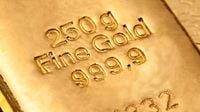The price of gold has surged to an all-time high of $3,157.23 per fine ounce following the recent announcement of new tariffs by US President Donald Trump. This latest increase marks a significant milestone in a year that has already seen gold prices reach record levels multiple times. The surge in gold prices reflects growing investor anxiety over Trump's unpredictable tariff policies and the potential for an escalating trade war.
On April 1, 2025, gold prices climbed to $3,148, just one day before Trump’s anticipated announcement regarding reciprocal tariffs. The metal's value has risen dramatically throughout the year, increasing by nearly 20 percent since January. In a broader context, gold has appreciated by 40 percent over the past year, driven by geopolitical tensions and inflation fears.
Independent metal trader Tai Wong commented on the situation, stating, "The retaliatory tariffs are significantly more aggressive than expected. The prospects for gold are excellent here, with $3,200 as the new short-term target." Wong's remarks underscore the sentiment among investors seeking safe havens amid rising market volatility.
In response to Trump’s tariff announcement, Canadian Prime Minister Mark Carney has pledged countermeasures, which are expected to be revealed on April 3, 2025. Carney emphasized the need for targeted and decisive actions, reflecting the broader concern among global leaders about the potential repercussions of US trade policies.
Adding to the complexities of the situation, US Treasury Secretary Scott Bessent has cautioned affected countries against retaliating, warning that such actions could lead to further escalation. He stated, "This could potentially lead to a global trade war, which would be detrimental to all parties involved." The US has imposed a 31 percent tariff on imports from Switzerland, further complicating international trade relations.
Moreover, Trump has ended the tariff exemption for smaller package shipments from China, a move aimed at combating the influx of illegal synthetic opioids. This regulation affects packages valued under $800, which have seen a staggering increase in volume, reaching nearly 1.4 billion in 2024. Approximately 60 percent of these packages originate from China, highlighting the significance of US-China trade dynamics.
Market analysts have noted that the gold price rally is not just a short-term phenomenon. Amy Gower, a commodity strategist at Morgan Stanley, remarked on the physical demand for gold and a favorable macroeconomic environment driving the price surge. Gower predicts that gold could reach between $3,300 and $3,400 later this year, aligning with forecasts from major banks like Goldman Sachs, which has raised its target for gold to $3,300 per ounce by year-end.
As fears of a global trade war loom, investors are increasingly turning to gold as a safe haven. This trend is evident in the significant inflows into physically backed gold ETFs, which have risen by 6 percent after years of net outflows. The first quarter of 2025 saw investors pour approximately $19 billion into gold ETFs, reflecting a strong shift in investment strategies.
Gold's appeal as a secure asset is further underscored by the performance of other traditional safe havens, such as US Treasury bonds, which have also seen increased demand. As financial markets react to Trump's tariff announcements, the volatility has prompted many investors to seek refuge in gold, which is often viewed as a hedge against inflation and economic uncertainty.
On April 2, 2025, the Dow Jones Industrial Average advanced by about half a percent, while the S&P 500 also rose slightly. However, futures markets reacted negatively to the tariff news, with Dow futures dropping over 900 points, or 2.19 percent, and S&P 500 futures declining by 3.38 percent. This stark contrast highlights the market's apprehension about the implications of Trump's trade policies.
Despite the strong performance of gold, some analysts caution that the market may be due for a consolidation period after such significant gains. The technical indicators suggest that gold has entered extreme territory, and the impending tariff announcement could trigger a classic "buy on the rumor, sell on the news" scenario.
In the midst of these developments, the geopolitical landscape remains fraught with tension. Ongoing conflicts, such as the situation in Ukraine and escalating violence in the Middle East, continue to exert pressure on global markets. The lack of progress towards a ceasefire in Ukraine and intensified military actions in Gaza have further contributed to the sense of uncertainty that drives investors toward gold.
As the world watches closely, the impact of Trump's tariff policies on both domestic and international markets will be a crucial factor in determining the future trajectory of gold prices. With analysts predicting continued volatility, the precious metal's status as a safe haven is likely to remain strong in the face of economic and political challenges.
In summary, the recent surge in gold prices is a reflection of heightened investor anxiety over trade tensions and economic uncertainties. As nations respond to the US's aggressive tariff strategy, the dynamics of global trade and investment will continue to evolve, influencing market behavior and the future of gold as a favored asset.









